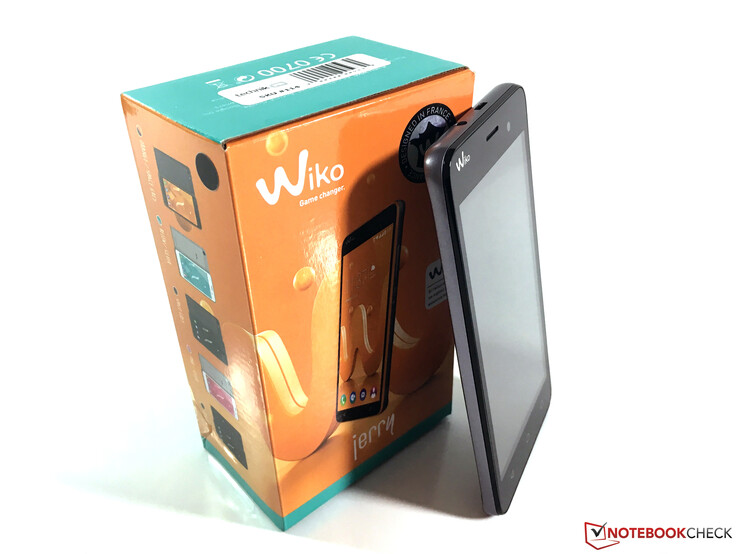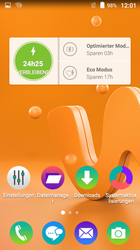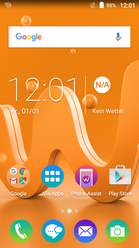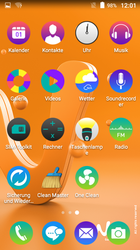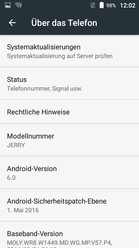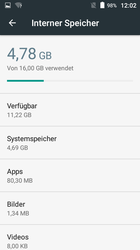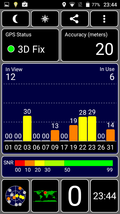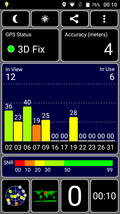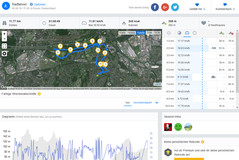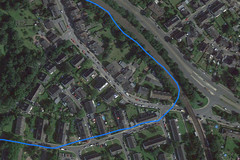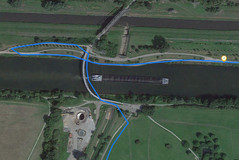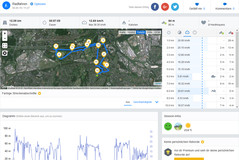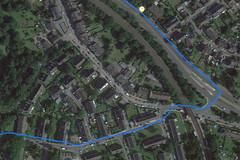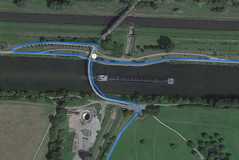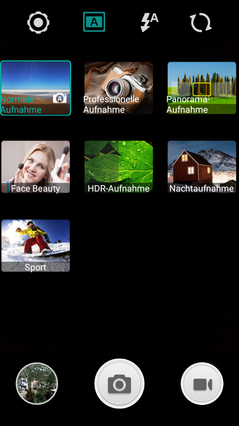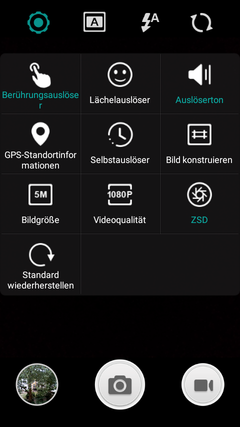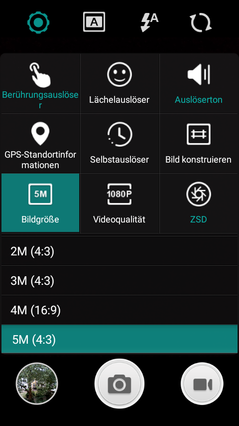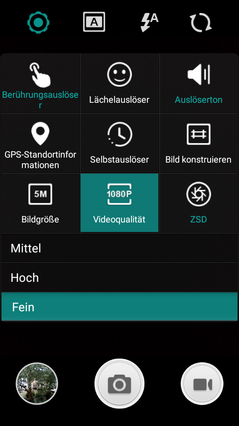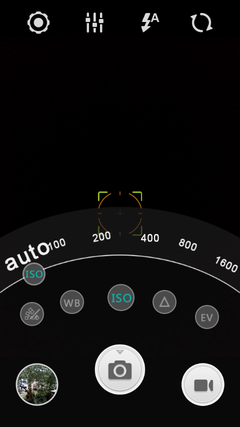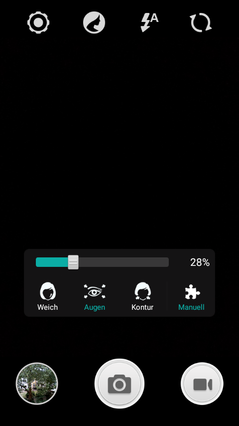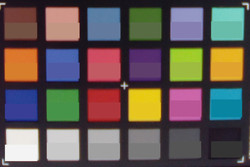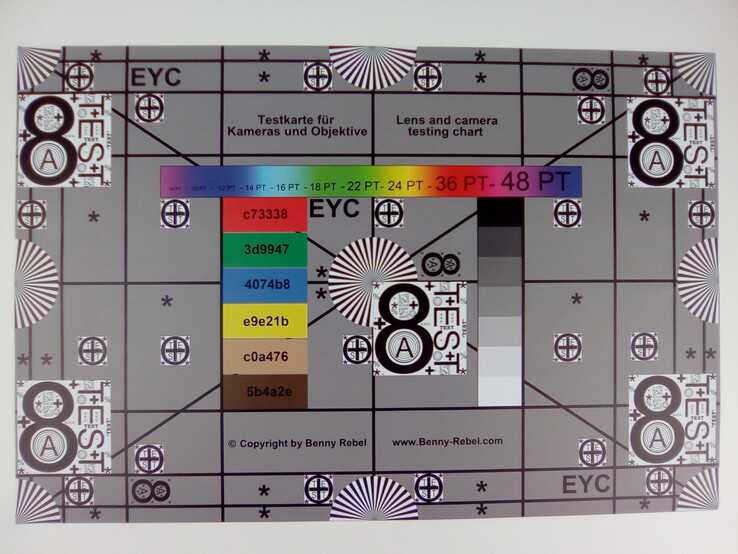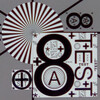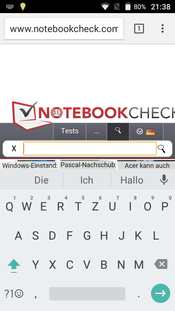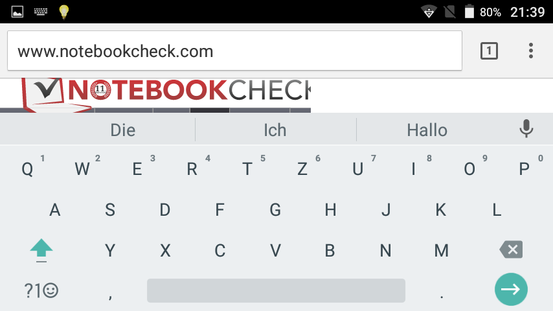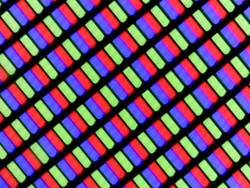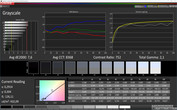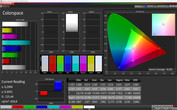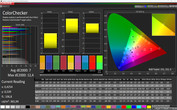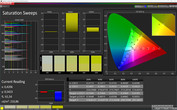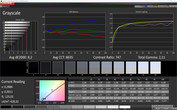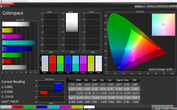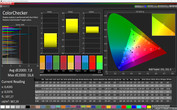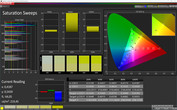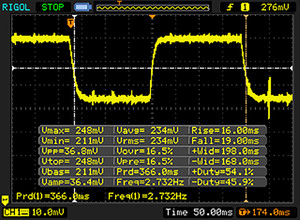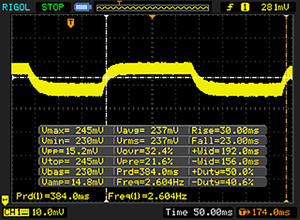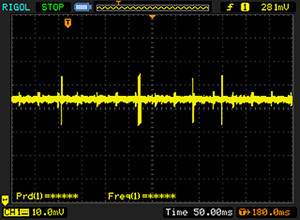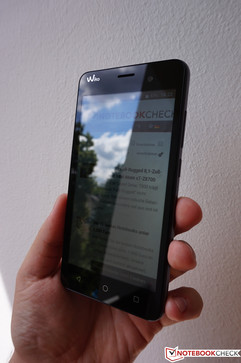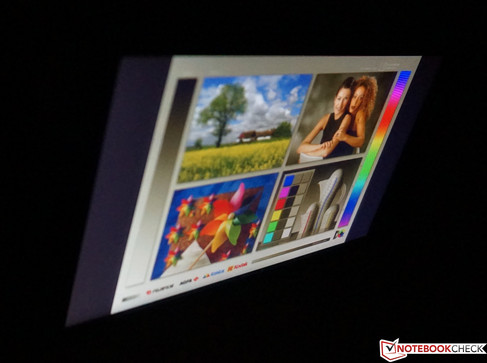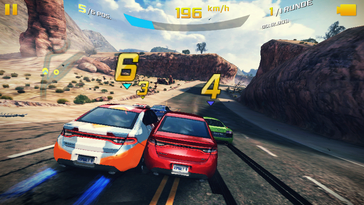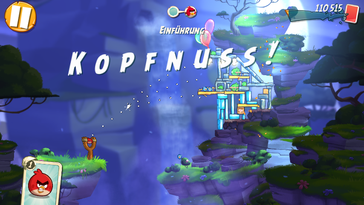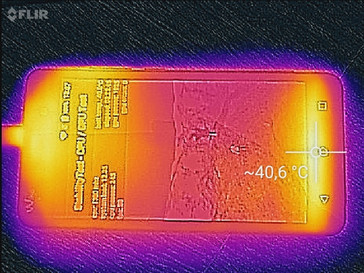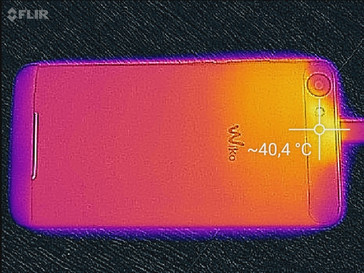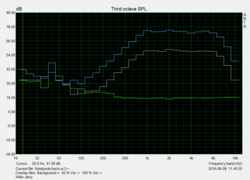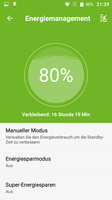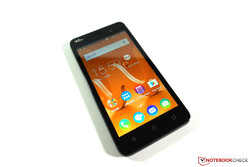Wiko Jerry Smartphone Review

For the original German review, see here.
After the Robby and Lenny 3 models by the French manufacturer Wiko, the new Jerry is in for closer examination. It also belongs to the manufacturer's "Easy & Fun" category that is intended to attract smartphone newcomers with colorful designs and easy handling. At an official purchase price of 99 Euros (~$110), Jerry is the cheapest of the three handsets. At first glance, the customer gets a lot for the money: a 5-inch IPS panel, quad-core SoC, dual-SIM, the latest Android 6.0, storage expansion via micro-SD and a removable battery. The only obvious shortcoming is the lack of LTE.
At a purchase price of 100 Euros (~$111, current street price ~90 Euros/~$100), Jerry is one of the cheapest models available and finds these rivals among others: Microsoft Lumia 550, LG K4, and ZTE Blade A452. We will also compare the review sample with both entry-level handsets by Wiko mentioned above.
Case
Considering that Wiko's Jerry has a 5-inch display, it is a relatively bulky handset. The comparatively high weight of 166 grams (~5.9 oz) and height of almost one centimeter (~0.4 in) create this impression. However, the screen's edges are also quite wide. The rear is curved lightly toward the edges so overall the handling is still comfortable. The rear is somewhat flatter at both the upper and lower edge and thus the camera lens juts out a bit from the casing.
Wiko speaks of a "metal design, with beautiful fresh colors" on Jerry's product page. At least the last point is true although our gray review sample is not the best example here. However, some models feature a colored peripheral edge (orange, cyan, pink, silver), but their backs (gray or silver) and the actual display edges (black or white) are considerably more restrained. A metal casing might even be presumed from a certain distance, but once touched the back cover seems to be made of plastic. Fingerprints are no problem and the back is not too slippery, either.
The relatively thick construction has some advantages like decent stability. Although a twist of the smartphone produces a quietly audible cracking noise, it was not disconcerting. In return, pressure from either the back or the front is no problem. The entire back cover can be removed and allows accessing the removable battery, both SIM slots (1x mini, 1x micro; adapter included), and the micro-SD card slot. The battery has to be removed before the SIM slots can be accessed. An LED is situated below Wiko's logo on the front. It displays the charging state (red or green) or new notifications (pulses in green).
Connectivity
Although some restrictions are found in connectivity, Wiko's Jerry makes a very good impression for an entry-level handset. The quad-core SoC finds support in 1 GB of RAM and apps can be installed on the 16 GB internal storage. The storage can also be expanded via a micro-SD card (max. 64 GB). The user has two options for use here: Either as a portable storage for photos and media that can also be used in other devices or, thanks to Android 6, as an internal storage for apps and media. However, the card can then only be used in conjunction with this smartphone.
The handset is not as generous with data transfer options as this is limited to Bluetooth 4.0 and Wi-Fi. Wi-Fi Direct, Miracast and NFC are not present. Music lovers will be happy about an FM radio that can be used with a headset (included).
Software
In contrast to some major phone builders, the French manufacturer Wiko relies on the latest Android 6.0 Marshmallow even for its entry-level devices. Of note is the slightly modified design with rounder and larger icons. A real app drawer is not present, and the apps are arranged in line on the home screens (folders are possible). However, Wiko also preloads an app dubbed "All Apps" where the apps are arranged alphabetically. Besides some proprietary tools (e.g. system cleaner) and the usual Google apps, we did not find any unneeded adware. This is also obvious in the storage since 10.2 GB are still available after updating all preloaded apps.
Communication & GPS
Wiko's Jerry does not support LTE connections, and it does not look very good with only four in the GSM and two bands in the UMTS networks, either. The smartphone is thus not very suitable for globetrotters. Only one of the two SIM cards can connect to data networks, which can also be determined in the settings during use. It does not matter which slot is used since both support UMTS. Local networks can only be accessed in the 2.4 GHz band (802.11 b/g/n), and we cannot use 5 GHz networks or the fast ac standard. The connection quality was satisfactory at a short distance in the practical test with a Fritz!Box 7490 and ASUS RT-AC56U. The connection, however, became increasingly worse at a slightly larger distance (5-10 meters/~16-33 ft), and websites needed a bit longer to load.
The smartphone can only utilize GPS (A-GPS) for localization. The position could only be determined near a window indoors, and the accuracy of 20 meters (~66 ft) was not very exact. It functioned better outdoors where the accuracy improved to 4 meters (~13 ft) according to the GPS test app. We compare the handset with Garmin's Edge 500 professional navigation system on a short bike trip. In addition to some shortcuts that are due to longer intervals between localization, a general aberration of a few meters is noticed in some places. The performance should be enough for navigating by car, but better solutions exist for tight bike trails or geocaching.
Telephone & Call Quality
The stock Android phone app is very clearly arranged and thus fulfills the entry-level claim of Wiko's Jerry. We can confirm the findings from the test of the more expensive Wiko Lenny 3 during calls. We did not experience any major issues with clarity, but the voices are quite muffled in general and background noise is not filtered very well. It is possible to prefer one of the two SIM cards for phoning in the settings. Alternatively, the handset asks which is to be used before every call. Despite its low price, a headset with remote control is included that fulfills its purpose for hands-free calls.
Cameras
Users of Wiko's Jerry should not put much importance on good photos. A sensor of only 2 MP is installed on the front, which does not produce reasonable photos even in good light conditions. Although a Beauty mode is present (see screenshot) that can assist a bit, it cannot perform miracles.
At first glance, the photos shot with the 5 MP primary camera are acceptable. However, a direct comparison with superior cameras shows that the photos are too dark. Many details are not reproduced. For example, a traffic sign is barely visible in the low-light scene. The low resolution is also noticed in zoomed photos. Videos can be recorded at a maximum of Full HD and 24 frames per second (setting "fine), but the user should not expect too much here, either.
We also photograph the ColorChecker Passport and test chart in test conditions for a better assessment of colors and image sharpness. The outcomes are not edited afterward. No big irregularities are seen in colors. Although slight aberrations are seen in some tones, overall it is not dramatic. It looks much worse with the test chart. The image becomes paler toward the edges, and the outcome is everything but sharp due to the low resolution in the center area (see section).
Accessories & Warranty
Wiko's Jerry comes with a 24-month warranty. However, the included accessories are only covered for 6 months. The French manufacturer also optionally offers a fitting protective cover dubbed "Flip Cover".
Input Devices & Handling
The capacitive touchscreen only supports two inputs at a time, and the gliding qualities could also be better. In general, we did not have any major problems. However, our inputs were not detected correctly in some cases. The Android buttons are implemented as sensor keys below the screen. They are not backlit and they cannot be remapped. The physical keys on the right fit perfectly in the casing and provide a pleasantly rich pressure point.
Wiko also relies on the virtual stock Android keyboard that is easy to use. Of course, other models can be downloaded from the Play Store when desired.
Display
The low price of Wiko's Jerry is also obvious in the installed screen: While the HD resolution (1280x720 pixels) has moved into many 5-inch models now, the review sample only has 854x480 pixels. This results in a low pixel density of 196 PPI and a very clear difference to higher-resolution models is evident. However, the user should be happy with it if it is his/her first smartphone.
Apart from a light bluish tint, the IPS panel cannot be criticized much subjectively. The maximum brightness is 455 cd/m² (APL50: 429 cd/m²), and the 91 percent illumination is very good. Only the black level of 0.57 cd/m² (APL50: 0.58 cd/m²) is a bit high. However, the contrast of 750:1 is still acceptable. The Jerry includes a brightness sensor as well, but its maximum or minimum is no brighter than what the user can set manually.
| |||||||||||||||||||||||||
Brightness Distribution: 91 %
Center on Battery: 432 cd/m²
Contrast: 758:1 (Black: 0.57 cd/m²)
ΔE ColorChecker Calman: 7 | ∀{0.5-29.43 Ø4.77}
ΔE Greyscale Calman: 7.6 | ∀{0.09-98 Ø5}
Gamma: 2.1
CCT: 8368 K
| Wiko Jerry IPS, 854x480, 5" | Microsoft Lumia 550 IPS, 1280x720, 4.7" | LG K4 TN-TFT, 854x480, 4.5" | ZTE Blade A452 IPS, 1280x720, 5" | Wiko Lenny 3 IPS, 1280x720, 5" | Wiko Robby IPS, 1280x720, 5.5" | |
|---|---|---|---|---|---|---|
| Screen | 9% | -26% | 0% | 2% | 18% | |
| Brightness middle (cd/m²) | 432 | 536 24% | 337 -22% | 446 3% | 374 -13% | 621 44% |
| Brightness (cd/m²) | 436 | 535 23% | 342 -22% | 411 -6% | 343 -21% | 576 32% |
| Brightness Distribution (%) | 91 | 95 4% | 92 1% | 83 -9% | 85 -7% | 88 -3% |
| Black Level * (cd/m²) | 0.57 | 0.62 -9% | 0.44 23% | 0.65 -14% | 0.47 18% | 0.73 -28% |
| Contrast (:1) | 758 | 865 14% | 766 1% | 686 -9% | 796 5% | 851 12% |
| Colorchecker dE 2000 * | 7 | 5.81 17% | 11.4 -63% | 6.29 10% | 6 14% | 4.7 33% |
| Colorchecker dE 2000 max. * | 12.4 | 12.3 1% | 22 -77% | 11.9 4% | 9.4 24% | |
| Greyscale dE 2000 * | 7.6 | 7.72 -2% | 11 -45% | 5.58 27% | 6.7 12% | 5.2 32% |
| Gamma | 2.1 105% | 2.18 101% | 2.19 100% | 2.04 108% | 2.19 100% | 2.51 88% |
| CCT | 8368 78% | 8701 75% | 9372 69% | 7636 85% | 8073 81% | 7505 87% |
* ... smaller is better
The option "MiraVision" provides the user with the predefined display modes "Standard" and "Vivid". Furthermore, a manual mode is available for easily adapting different parameters (contrast, saturation, image brightness, sharpness, color temperature) via a slider and previews. We performed the display measurements using the predefined "Standard" and "Vivid" profiles. Both display high DeltaE 2000 shifts, though. Overall, the panel in Wiko's Jerry is only in the lower field of the comparison devices, but it will not lead to major restrictions in practical use.
Display Response Times
| ↔ Response Time Black to White | ||
|---|---|---|
| 35 ms ... rise ↗ and fall ↘ combined | ↗ 16 ms rise | |
| ↘ 19 ms fall | ||
| The screen shows slow response rates in our tests and will be unsatisfactory for gamers. In comparison, all tested devices range from 0.1 (minimum) to 240 (maximum) ms. » 92 % of all devices are better. This means that the measured response time is worse than the average of all tested devices (20.2 ms). | ||
| ↔ Response Time 50% Grey to 80% Grey | ||
| 53 ms ... rise ↗ and fall ↘ combined | ↗ 30 ms rise | |
| ↘ 23 ms fall | ||
| The screen shows slow response rates in our tests and will be unsatisfactory for gamers. In comparison, all tested devices range from 0.165 (minimum) to 636 (maximum) ms. » 90 % of all devices are better. This means that the measured response time is worse than the average of all tested devices (31.6 ms). | ||
Screen Flickering / PWM (Pulse-Width Modulation)
| Screen flickering / PWM not detected | |||
In comparison: 53 % of all tested devices do not use PWM to dim the display. If PWM was detected, an average of 8084 (minimum: 5 - maximum: 343500) Hz was measured. | |||
The review sample does a good job outdoors. Screen contents can still be read decently even in bright surroundings as long as direct reflections can be prevented on the glossy touchscreen. The IPS panel does not show shortcomings in viewing angle stability, either. Apart from the usual minor brightness loss in extreme viewing angles, we found no limitations.
Performance
Interestingly, Wiko's three entry-level models (Jerry, Lenny 3, and Robby) are all equipped with identical core components: MediaTek's MT6580M SoC (no 64-bit support) in conjunction with an ARM Mali-400 MP2 GPU and 1 GB of RAM. The quad-core's performance (max. 1.3 GHz) is sufficient for routine tasks. However, waiting times or minor stutters have to be expected in practical use. But that is the case in many low-cost handsets. Unsurprisingly, Wiko's three smartphones are roughly on par in the benchmarks. The Lenny 3 only takes a lead in the latest AnTuTu benchmark.
The Mali-400 MP 2 graphics card only supports OpenGL ES 2.1, but not the versions 3.0 or 3.1. Thus, we could not perform some benchmarks on the review sample to begin with. However, its performance is on the expected (low) level. The Jerry should have a slight advantage over its brothers in gaming thanks to the lower resolution though.
| AnTuTu v6 - Total Score | |
| Microsoft Lumia 550 | |
| ZTE Blade A452 | |
| Wiko Lenny 3 | |
| LG K4 | |
| Wiko Robby | |
| Wiko Jerry | |
| Geekbench 3 | |
| 32 Bit Multi-Core Score | |
| LG K4 | |
| Wiko Lenny 3 | |
| Wiko Robby | |
| Wiko Jerry | |
| 32 Bit Single-Core Score | |
| LG K4 | |
| Wiko Robby | |
| Wiko Jerry | |
| Wiko Lenny 3 | |
| 3DMark | |
| 1280x720 offscreen Ice Storm Unlimited Score | |
| ZTE Blade A452 | |
| Wiko Jerry | |
| Wiko Robby | |
| Wiko Lenny 3 | |
| LG K4 | |
| 1280x720 offscreen Ice Storm Unlimited Graphics Score | |
| ZTE Blade A452 | |
| Wiko Jerry | |
| Wiko Robby | |
| Wiko Lenny 3 | |
| LG K4 | |
| 1280x720 offscreen Ice Storm Unlimited Physics | |
| Wiko Robby | |
| Wiko Lenny 3 | |
| Wiko Jerry | |
| ZTE Blade A452 | |
| LG K4 | |
| 1280x720 Ice Storm Standard Score | |
| ZTE Blade A452 | |
| Wiko Jerry | |
| LG K4 | |
| 1280x720 Ice Storm Standard Graphics | |
| ZTE Blade A452 | |
| LG K4 | |
| Wiko Jerry | |
| 1280x720 Ice Storm Standard Physics | |
| Wiko Jerry | |
| ZTE Blade A452 | |
| LG K4 | |
| 1920x1080 Ice Storm Extreme Score | |
| Wiko Jerry | |
| ZTE Blade A452 | |
| LG K4 | |
| 1920x1080 Ice Storm Extreme Graphics | |
| Wiko Jerry | |
| ZTE Blade A452 | |
| LG K4 | |
| 1920x1080 Ice Storm Extreme Physics | |
| Wiko Jerry | |
| ZTE Blade A452 | |
| LG K4 | |
| GFXBench (DX / GLBenchmark) 2.7 | |
| T-Rex Onscreen | |
| LG K4 | |
| Wiko Jerry | |
| ZTE Blade A452 | |
| Wiko Lenny 3 | |
| Wiko Robby | |
| Microsoft Lumia 550 | |
| 1920x1080 T-Rex Offscreen | |
| ZTE Blade A452 | |
| Wiko Robby | |
| Wiko Jerry | |
| Wiko Lenny 3 | |
| LG K4 | |
| Microsoft Lumia 550 | |
| PCMark for Android - Work performance score | |
| Wiko Lenny 3 | |
| Wiko Robby | |
| LG K4 | |
| Wiko Jerry | |
Wiko waives a proprietary browser and relies on Chrome instead. The benchmarks were performed with version 51. Wiko's three smartphones again present a similar outcome and are usually at the end of the comparison chart. Only LG's K4 sometimes performs worse. Internet browsing is not much fun subjectively, either. More complex pages often need time to load and stutter quite a bit.
| JetStream 1.1 - Total Score | |
| ZTE Blade A452 | |
| Wiko Lenny 3 | |
| Wiko Jerry | |
| Wiko Robby | |
| Microsoft Lumia 550 | |
| LG K4 | |
| Octane V2 - Total Score | |
| ZTE Blade A452 | |
| Microsoft Lumia 550 | |
| Wiko Robby | |
| Wiko Lenny 3 | |
| Wiko Jerry | |
| LG K4 | |
| Mozilla Kraken 1.1 - Total | |
| Microsoft Lumia 550 | |
| LG K4 | |
| ZTE Blade A452 | |
| Wiko Robby | |
| Wiko Jerry | |
| Wiko Lenny 3 | |
* ... smaller is better
The user should not expect any record-breaking speeds from the 16 GB internal storage. The module's write rates are particularly poor and are on the low level of Wiko's Lenny 3 in total. That is also true for the micro-SD reader that we test in conjunction with our Toshiba reference card (Exceria Pro M401, max. 95 MB/s read & 80 MB/s write). The card remains below its potential in the Jerry with 41 and 19 MB/s. However, we have recorded even worse performances.
| Wiko Jerry 16 GB eMMC Flash | LG K4 8 GB eMMC Flash | ZTE Blade A452 8 GB eMMC Flash | Wiko Lenny 3 16 GB eMMC Flash | Wiko Robby 16 GB eMMC Flash | |
|---|---|---|---|---|---|
| AndroBench 3-5 | -15% | -13% | -1% | 51% | |
| Sequential Write 256KB SDCard (MB/s) | 19.12 | 18.7 -2% | 19.59 2% | 19.68 3% | |
| Sequential Read 256KB SDCard (MB/s) | 40.91 | 28.52 -30% | 40.59 -1% | 41.39 1% | |
| Random Write 4KB (MB/s) | 6.4 | 4.97 -22% | 4.76 -26% | 6.2 -3% | 6.9 8% |
| Random Read 4KB (MB/s) | 14.97 | 16.05 7% | 16.1 8% | 15.1 1% | 15.7 5% |
| Sequential Write 256KB (MB/s) | 12.11 | 8.07 -33% | 8.53 -30% | 11.6 -4% | 47.6 293% |
| Sequential Read 256KB (MB/s) | 132.8 | 120.8 -9% | 125.7 -5% | 132.5 0% | 126.2 -5% |
Games
As mentioned before, Wiko's Jerry can benefit a bit from its screen's low resolution in games. Thus, in contrast to the Lenny 3, the fast-paced racing game "Asphalt 8: Airborne" can still be played fairly well even in medium details. However, minimum details should be selected for really smooth gameplay. More basic games like "Angry Birds 2" are of course no problem and the sensors function reliably. However, the only two touch points could be limiting for some games (e.g. music games).
Emissions
Temperature
Despite the relatively low performance, Wiko's Jerry is not a cool smartphone. The lower front area heats up to just below 35 °C (95 °F) while idling. During load, it averages over 38 °C (100.4 °F) on the front and 36 °C (96.8 °F) on the back. Although that is palpable, it is not annoying thanks to the even distribution without extreme hot spots.
(±) The maximum temperature on the upper side is 40 °C / 104 F, compared to the average of 35.2 °C / 95 F, ranging from 21.9 to 247 °C for the class Smartphone.
(+) The bottom heats up to a maximum of 38 °C / 100 F, compared to the average of 34 °C / 93 F
(±) In idle usage, the average temperature for the upper side is 32.2 °C / 90 F, compared to the device average of 32.9 °C / 91 F.
Speaker
The speaker in Wiko's Jerry is situated on the rear (slot in the lower area), and could sound muffled on soft surfaces. The module is sufficiently loud at 85 dB(A), but the output is treble-heavy while low tones are almost absent. This distorts the sound a bit primarily in higher volumes. It is enough for occasionally playing YouTube videos or quiet background music. This is also true for the included headset. Good headphones or external speakers should be connected to the jack or via Bluetooth for better results. The output via the jack is unexceptional.
Energy Management
Power Consumption
Like Wiko's Lenny 3, the Jerry is not a frugal handset. The cheaper review sample even consumes a bit more power during load and its maximum of 5.52 watts is slightly higher than the nominal output of the 5-watt power supply. The latter does not get very warm even during load though. The standby consumption of 0.41 watts is a bit too high. There is still room for improvement here.
| Off / Standby | |
| Idle | |
| Load |
|
Key:
min: | |
| Wiko Jerry 5", 7.4 Wh, 2000 mAh | Microsoft Lumia 550 4.7", 8 Wh, 2100 mAh | LG K4 4.5", 7.4 Wh, 1940 mAh | ZTE Blade A452 5", 15 Wh, 4000 mAh | Wiko Lenny 3 5", 7.4 Wh, 2000 mAh | Wiko Robby 5.5", 9.5 Wh, 2500 mAh | |
|---|---|---|---|---|---|---|
| Power Consumption | 2% | 15% | -41% | 0% | -8% | |
| Idle Minimum * (Watt) | 0.8 | 0.55 31% | 1.15 -44% | 1.7 -113% | 0.76 5% | 0.92 -15% |
| Idle Average * (Watt) | 2.02 | 2.69 -33% | 1.76 13% | 3.08 -52% | 2.16 -7% | 2.12 -5% |
| Idle Maximum * (Watt) | 2.19 | 2.93 -34% | 1.82 17% | 3.25 -48% | 2.35 -7% | 2.34 -7% |
| Load Average * (Watt) | 5.02 | 3.94 22% | 2.71 46% | 4.81 4% | 4.65 7% | 5.3 -6% |
| Load Maximum * (Watt) | 5.52 | 4.24 23% | 3.15 43% | 5.27 5% | 5.35 3% | 5.78 -5% |
* ... smaller is better
Battery Runtime
Since Wiko's Jerry and Lenny 3 both have the same batteries (2000 mAh, 7.4 Wh), we expect our review sample to have a slightly shorter battery life than the Lenny 3 due to its somewhat higher power consumption. Our Wi-Fi test confirms this, but almost 8 hours is still a good outcome.
In case a longer battery life is needed, one of the two known energy-saving modes can be used. The handset needs approximately 2 hours for completely recharging the battery when it is on.
| Wiko Jerry 2000 mAh, 7.4 Wh | Microsoft Lumia 550 2100 mAh, 8 Wh | LG K4 1940 mAh, 7.4 Wh | ZTE Blade A452 4000 mAh, 15 Wh | Wiko Lenny 3 2000 mAh, 7.4 Wh | Wiko Robby 2500 mAh, 9.5 Wh | |
|---|---|---|---|---|---|---|
| Battery runtime | ||||||
| WiFi v1.3 (h) | 7.9 | 7.4 -6% | 7.5 -5% | 13.6 72% | 9.2 16% | 11.9 51% |
Pros
Cons
Verdict
Wiko's Jerry for just below 90 Euros (~$100) was a nice surprise in some aspects. No one should be astonished that some compromises have to be made at this price. Among them, for example, the poor cameras and the lack of both LTE and NFC, and the screen could also be sharper.
Nevertheless, Wiko's Jerry offers some features that are not available in other entry-level models. For example, the French manufacturer installs the latest Android 6.0 Marshmallow with the option of expanding the internal storage via a micro-SD card. Furthermore, two SIM slots (including corresponding adapters) and a decent battery life are present.
Wiko's Jerry does a proper job in many aspects for just 90 Euros. The buyer should just not expect too much in terms of cameras and frequency coverage (no LTE).
Wiko Jerry
- 07/30/2016 v5.1 (old)
Andreas Osthoff




